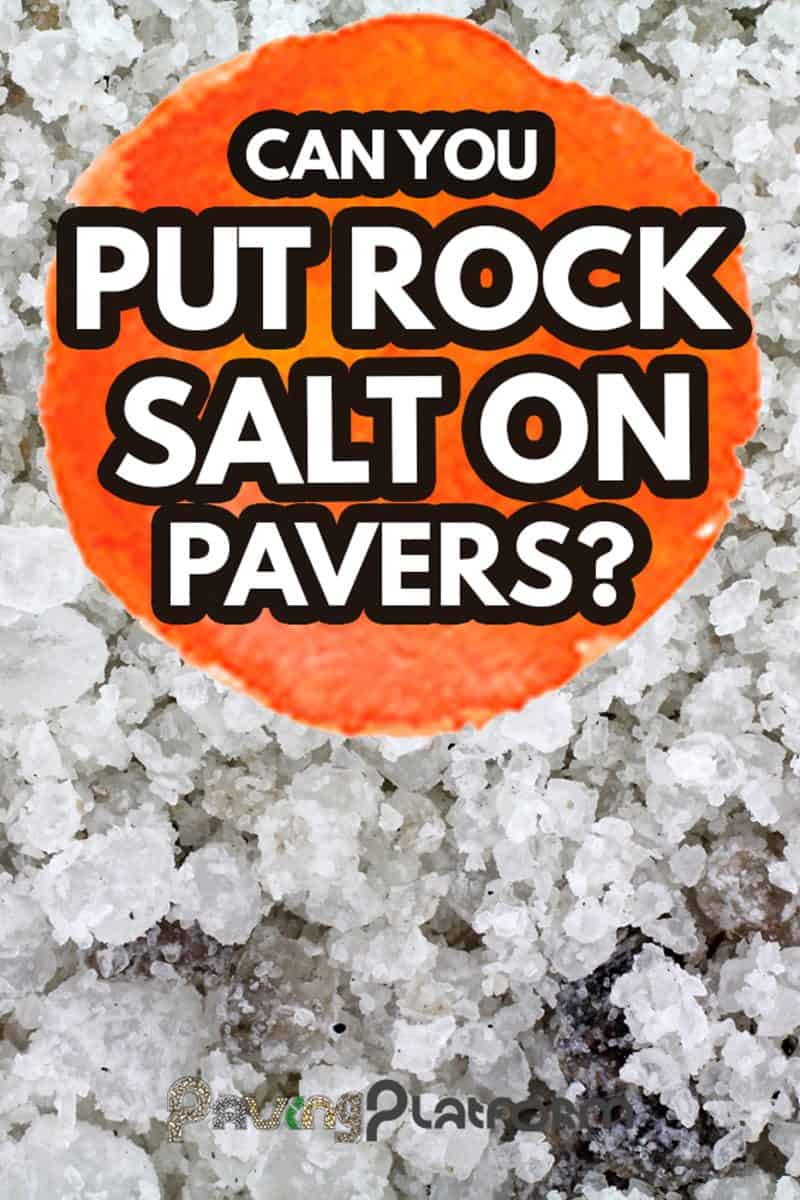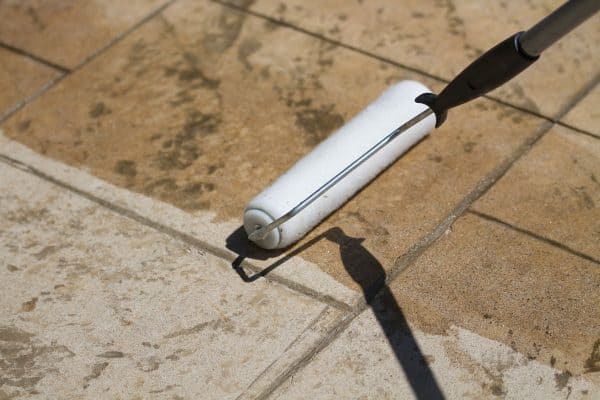Disclosure: We may get commissions for purchases made through links in this post.
Filling the gaps on your pavers is a smart way to stabilize their structure, especially during the winter season. There a various ways to fill in paver gaps, but is rock salt a great choice? If you are looking for an answer to this question, don't fret because we researched everything you need to know for your pavers' sake.
Whether your pavers are composed of natural stones, concrete, or bricks, it is not recommended to put rock salt on pavers because salt damages all surfaces. Rock salt is only used for asphalt roads for de-icing.
Rock salts are not completely useless, however, as they also have their own advantages. Keep reading to find out in detail their negative effects as well, and yet, why many Americans can't help but use them on their pavers.

Downsides Of Applying Rock Salt On Pavers

Rock salt is corrosive and can cause damage to the surface of your pavers if it is excessively used for a long period of time.
Nonetheless, rock salt can still be applied on pavers if you really wish to. But you need to ensure that it is applied properly and that your safety is the priority when salting your pavers in the patio or driveway.
Most pavers are manufactured to have a very high compressive strength around 8,000-12,000 psi. Because of this, they can appear very dense and more durable. However, poured-concrete pavers can be very weak as they contain more porous materials that can be easily damaged.
According to CLC Landscape Designs, here are possible negative effects that can arise when you apply rock salt on pavers:
- Rock salt causes flaking to your patio or driveway pavers.
- Rock salt can damage indoor flooring.
- Rock salt is bad for pets as it causes irritation on their paws and can even be ingested in excessive amount.
- Rock salt causes salt fretting.
- Rock salt causes discoloration, making your pavers surfaces look bleached or hazed, specially on natural stone or blue stone products.
- Rock salt is harmful to plants, and its accumulation in the soil may lead to damaged plant roots.
- Rock salt can be very corrosive specifically to concrete. A salt crystal can eat into the paver's surface resulting to a pock mark since pavers are in essence pressed conrete products.
- Rock salt is also corrosive to mortared joints, weakening them in effect and will make them loose.
Rock Salt As A De-Icing Agent

Rock salt is mostly used on asphalt roads for deicing, and it works by lowering the freezing point of water.
When salt is combined with water, the freezing point of salty water will help lower the freezing point of fresh water. For instance, if the temperature is around 20 °F, the snowmelt and rock salt combination remains liquid. However, if the temperature is below 20 °F, the salty water will likely turn into ice.
In the case of temperature rising and dropping from the 20 °F thresholds, it will constantly thaw and freeze.
You can take a look at this YouTube video by Reactions for an entertaining discussion and additional information on how salt melts ice.
When Should You Apply Rock Salt?
Spreading rock salt is one of the most standard materials to handle icy pathways.
But as stated above, rock salt is used as a de-icing agent for asphalt roads and its effects on pavers can be extremely harmful. However, rock salts still seem like a very attractive option for deicing your pavers since a majority of Americans are still using them.
If you can't avoid doing the same, you might as well take note of the following tips:
- Treat the ground before snowfall begins. Doing so helps prevent ice from forming and stops snow from settling. It helps prevent moisture to freeze on the surfaces you have treated.
- You need to shovel more and salt less. Keeping up with snow as it falls slows down ice from developing.
- Rock salt can stop working when temperature drops below 15 °F. You need to ensure then that the temperature is right when you put on some rock salt.
- Make use of a garden spreader to manually spread the rock salt on your pavers. This tool gives you great control over the amount of salt being sowed. Using more salt to achieve melting is wrong. In fact, only four pounds of salt is required for every 1,000 square feet being treated so spread wisely.
- Rock salt does not magically disappear when the freezing or thawing subsides. It can melt into nearby creeks and wetlands, resulting to bringing harm to aquatic life. To prevent this from escalating, you need to sweep off extra salt on your pavers and rinse it thoroughly with water. You may reuse the excess or you can properly dispose it for good.
For more tips and information on salting your paver patio, watch this YouTube video by Pavers Savers:
You might also want to learn from this discussion on salting your driveway by Chris Works Outside:
What Do You Put On Your Pavers Instead Of Rock Salt?

While rock salt seems like one of the most readily available options, there are alternative products that you can consider such as the following:
CMA (Calcium Magnesium Acetate)
CMA works incredibly well in low temperatures. It is also guaranteed safe for children, pets, and the environment.
You can buy calcium chloride rock salt coated with CMA, but you can still opt for the salt-free and biodegradable one. It acts quickly on freezing temperatures and has an anti-corrosion formula that reduces the risk of damaging concrete or metal surfaces.
Click here to see Snow Joe's CMA deicer on Amazon.
Calcium Chloride
One great thing about this deicer is that it minimizes tracking so that the ice melts can remain on your pavers instead of coming indoors. It is also less likely to spread around and displace into gaps between pavers. Additionally, it won't hurt your plants. However, there is a possibility that this can corrode metals.
Calcium chloride works impressively well in temperatures that are as low as 25 °F. It also reduces the risk of spalling.
Potassium Acetate
This deicer is not harmful as it is biodegradable, non-corrosive, and non-toxic. This type of deicer can be very costly, and it doesn't guarantee that it will work well in extremely cold weather.
Magnesium Chloride
Magnesium chloride works well in cold weather. However, too much of this will make your pavements wet. It can also damage concrete. Go for a magnesium chloride deicer that is safe for pets. It won't burn or irritate their paws and fur. It works at low temperatures down to 13 °F.
Click here to see Harriss magnesium chloride deicer on Amazon.
How Does Rock Salt Stain Concrete?

The law of science is behind all of this. Rock salt stains concrete with the chemical reactions on the surface of the pavers. Pavers are generally made with white-grey concrete and the calcium hydroxide found in the concrete reacts with the calcium chloride that is present in rock salt.
This reaction creates CAOXY (calcium oxychloride) in salt that causes mayhem to their chemical substances. When CAOXY forms inside of concrete, it expands and causes concrete pavers to crack, crumble, and stain.
For additional insights on rock salt damaging concrete, you can listen to Dr. Scott Koefod's discussion on the effect of salt on concrete in this video below:
In Closing
Rock salt can cause damage to your pavers. However, if it's unavoidable, you can still make use of it as long as you keep track of proper application and guidelines. Also, keep your household safety a number one priority. Stay safe and brace your pavers well for the forthcoming winter.
If you have enjoyed this discussion, you can also check out the following articles:



![Vibrant Red Paver Stone Path, Can You Spray Paver Sealer? [How To Apply It]](https://pavingplatform.com/wp-content/uploads/2022/04/Vibrant-Red-Paver-Stone-Path-600x400.jpg)
![Properly laid out red pavers for a garden, Can You Tint Paver Sealer? [And How To]](https://pavingplatform.com/wp-content/uploads/2022/04/Properly-laid-out-red-pavers-for-a-garden-600x400.jpg)
